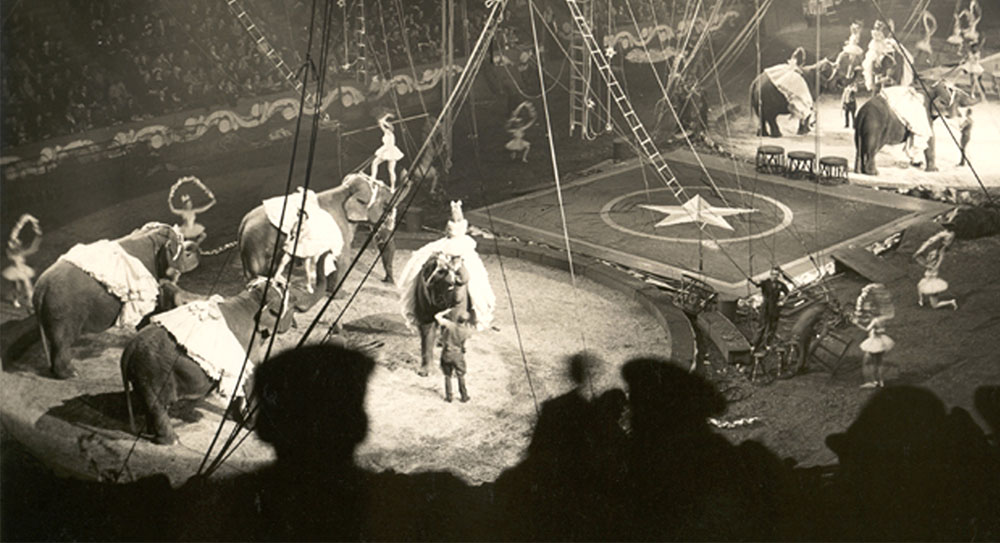What did people do for fun 100 years ago? Around that time, society was changing. The average worker had more leisure time. Radio was in its infancy and its cost was out of reach for most. There were silent films and performances, but nothing drew a crowd like a circus!
Going to the Circus in the mid 1800s in Cincinnati
When the weather turned warm, a circus would set up shop in any of a number of large open spaces outdoors, usually in Cumminsville and Norwood.
Others, like the John Robinson circus, set up tents on lots in or closer to the city. Lincoln Park in the West End was a popular location, as was the parcel of land at 14th and Elm. In the mid 1800s, it was called the Orphan Asylum lot. The Saengerfest Hall was built on that lot, and, in 1876, was torn down to make way for the construction of Music Hall.
The Coffered Ceiling Became a Big Top
In the Industrial Expositions, all kinds of performances and displays were held in Music Hall’s Springer Auditorium. So when the Shriners approached the manager of Music Hall about bring a circus, indoors, to the stage, he likely didn’t bat an eye.
The Shriner’s Mammoth Indoor Circus
In 1922 the first real indoor circus was held in Music Hall.
This feat was made possible by the Syrian Temple, Ancient Arabic Order Nobles of the Mystic Shrine. And like everything the Shriners present, this circus was first class all the way. They hired the best professionals from Barnum & Bailey and Ringling Brothers, and also featured John Robinson’s elephants. The acts included:
- The world-renowned Nelson family of tumblers and acrobats
- Edwin “Poodles” Hanneford, who was considered one of the greatest trick riders in history, the first to perform a somersault between two running horses.
- The famous Siegrist aerialist performers
- The internationally-known Riding Hodginis, equestrians extraordinaire
- Lester, Bell and La Rock, lady gymnasts
- A wide assortment of clowns
While all the events thrilled the audience, one in particular upped the excitement level. A Japanese wire walker made his way up a tight rope, which extended from the orchestra, over the audience and up to the gallery/second balcony! He then slid back down the rope, gracefully hopping off in an aisle near the stage.
John Robinson
Heading the list of attractions for the Music Hall stage was John G. Robinson’s Military Elephants. They staged a miniature battle and fired cannons. The elephants then formed a hospital corps to care for those wounded in the staged fight.

The Robinson’s most famous pachyderm was “Tillie,” said to be the oldest elephant in captivity. She was billed to be 105 – although later her age was set at roughly half that – and her other claim to fame was that she could say “Papa.” For two afternoons following matinees, Tillie held a reception for children on the Music hall stage. They could not only meet Tillie but also feed her peanuts.
By the time this circus was held, the Robinson family – four generations strong – had sold the circus, but out of fondness, they kept the elephants. The Robinson’s had an estate just east of Cincinnati. When they weren’t performing, the elephants lived with the Robinson’s in Terrace Park. An elephant house was built on the property along with a training ring.
Tillie was quite famous, performing at children’s hospitals and homes for the aged. She also helped raise money during government bond drives. Legend has it that after Tillie died in 1932, she was buried in Terrace Park.

The Shrine Circus at Music Hall
The Shriners ensured that the entire circus atmosphere was authentic. They provided for side shows, as well as the usual circus concessions of popcorn, peanuts and lemonade.
There were eleven performances over the week, five of which were matinees.
A Society Circus
The Shriners billed this as a “society circus.” The term was used to ensure people knew the circus was not only professional but also for everyone. It could also be used to indicate that the circus audience would be inclusive.
As is part of their mission, the Shriners ensured that children less fortunate – those that were orphans or in homes – got a chance to see the circus. Hundreds of children were brought to Music Hall for the matinee. Each child was presented with a bag of peanuts and a ball of popcorn to enjoy while watching the circus.
World War I veterans also were invited, especially those who were in hospitals and suffered with disabilities.
A Great Success
Following the last performance, The Syrian Temple Shriners said the circus would be an annual affair. The Shriners were pleased with the success, particularly because of the joy the circus brought to the children, even though the run fell short financially.
In subsequent years, though, the circus brought financial success. The Shriners held their indoor circus at Music Hall through 1927. They then moved to the newly-constructed Taft Auditorium, part of the new Masonic Temple.

